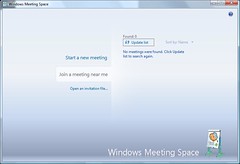Whenever we think about increasing our computer's performance, the first thing we think of is increasing RAM (memory). For the novice computer user, opening up the case and installing memory is out of the realm of consideration. An easy way to increase the memory is to use the ReadyBoost feature of Windows Vista.
When you try to do things on your computer that don't have enough RAM, the system uses the paging file. The paging file is a small area on the hard disk that is used and is called virtual memory.
When information is swapped back and forth between physical and virtual memory, it is called paging. The more memory the system has, the less the system has to access the hard disk to retrieve data, and the faster the performance. However, more RAM is not always a good option. Your system might not have the capability to hold more RAM, not to mention the fact, that RAM is not cheap.
Windows Meeting Space is a peer-to-peer collaboration program that allows you to share documents, programs, or your desktop with others.
You can share your desktop or a program with other meeting participants. You and the other meeting participants can share and co-edit documents. One saved change is replicated immediately to every other meeting participant. Any file or application can be broadcast or streamed, not just Microsoft applications. The administrator has the ability to limit the file types that can be shared. The built-in logging feature can audit activity and write to the event log during a session. You can pass notes among the participants. You can connect to a network projector for a presentation.
Windows Meeting Space automatically creates an ad hoc network, if it can't find an existing network. You can start a new meeting or join a meeting someone else has set up. You can invite others on the network to join. You have password protection and the session initiator decides who can join the session.
Windows will automatically configure Windows Firewall the first time you start Windows Meeting Space. You will be prompted to setup and enable People Near Me.
Imagine this scenario. You have called tech support and the technician is asking you what version of Windows is on your desktop computer. While troubleshooting, the technician asks how much memory is installed and how much hard drive space is available.
Imagine this scenario. The IT department is installing new wireless network cards in all employee laptops. You are a technician and you have been assigned the task of verifying the laptops that need new network adapters.
In either case, precious minutes are wasted scrolling though several diagnostic screens in control panel to get to the information, or you waste time asking the user questions they probably have no answer for.
BGinfo is a really cool, free, Sysinternals utility written by Bryce Cogswell. BGinfo queries the Windows system and displays information on your desktop, such as ip address, computer name, memory, volumes and free space, Mac address, etc. BGinfo writes a bitmap on your desktop and exits. No system resources are consumed and it does not interfere with other programs. You can put it in your start up folder so it displays current data every time you boot. BGinfo is customizable and even lets you select the background color and wallpaper. Voila! You have the system info right at your fingertips.
Mark Russinovich, of Sysinternals, has written an article about BGinfo in windowsitpro magazine. Go check Windows Sysinternals out, and while you are at it, check out some of the other free utilities these gods have written and check out some of Mark's Webcasts. See my page autoruns-another-awesome-freee-utility.html referencing another one of my very FAVorite system utilities written by Mark Russinovich.
Tutorial of BGinfo from Sysadmingeek
Users are reporting problems connecting to a host. The firewall on the host is configured to block incoming ICMP packets. The host is on the same IP subnet as your computer.
What tool can be used to test whether the host is connected to the network?
You can use arping. The arping command sends Address Resolution Protocol (ARP) packets to test connectivity. But, since ARP is not a routable protocol, the computers must be located on the same subnet.
What is arping?
 Image via Wikipedia
Image via Wikipedia



